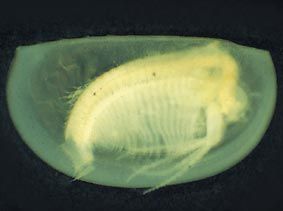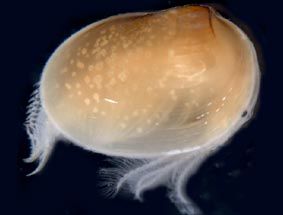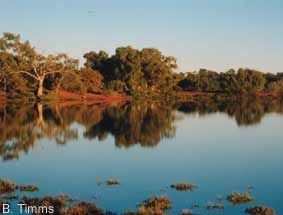Major Group: Crustacea
Minor Group: Conchostraca |
Descriptive Features: bivalved carapace, enclosing whole animal, growth lines visible OR absent
10 to > 30 pairs of trunk appendages, pairs 1 or 2 clawed (males), pairs 9-11 modified to carry eggs (females)
conspicuous head
short paired uniramous antennules, longer paired biramous antennae used for swimming
rostrum present on head anteriorly, small antero-dorsal structure present or absent
sessile compound eyes, dorsally, close together
Total length: up to 25 mm |

|
Limnadiidae |
|
|

|
Cyzicidae |
|
Taxonomic Checklist: Families
Cyzicidae
Cyclestheridae: Cyclestheria hislopi Baird
Limnadiidae
Leptestheriidae: Eoleptestheria ticinensis Balsamo-Crivelli
Lynceidae: Lynceus
|
|
Distribution: Australia wide. All but 1 species (Cyclestheria hislopi) are endemic.
Sensitivity Rating: SIGNAL grade 1
Functional Feeding Group: filtering collectors |

|
Pine Lake, Paroo NSW |
|
|
Ecology: Instream habitat: Conchostraca species occur in ponds, dams, rock pools, temporary pools, turbid freshwater clay pans and permanent lakes.
Feeding ecology: Clam shrimps are omnivores and filter feeders. Conchostracan blooms can become a problem in aquaculture ponds by reducing the production of other zooplankton and phytoplankton eaten by juvenile fish.
Habit: Clam shrimps are free swimming, skimming slowly along the substratum.
Life history: Eggs are carried in a brood pouch until the female moults or dies. Species from temporary waters have only one generation per wet period. Eggs require a drying period before hatching and so are resistant to desiccation. |
| |
Information Sources: Timms 2009a, 2009b, Timms & Richter 2009, Richter & Timms 2005, Williams 1980, Ingram et al. 1997, Hawking & Smith 1997
Key to Families: Timms 2009b
Key to Genera: Timms 2009b
Timms & Schwentner 2012 (Limnadiidae, world) refers to Rogers et al. 2012 (Limnadiidae, world, incomplete)
Key to Species: Timms 2009a (Limnadopsis) |
|
|
|